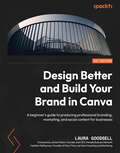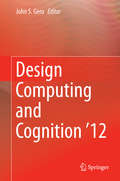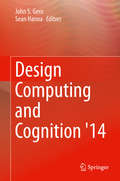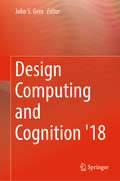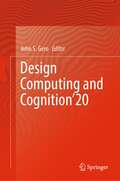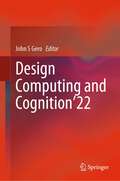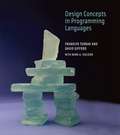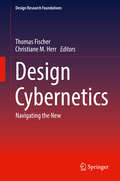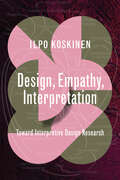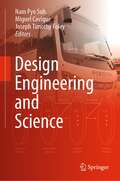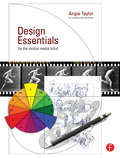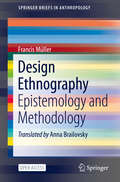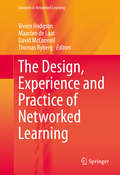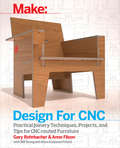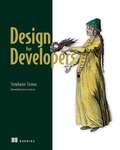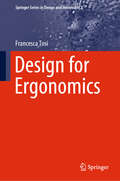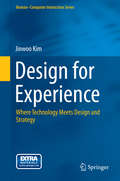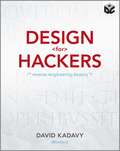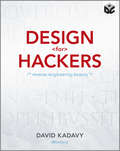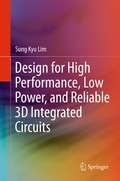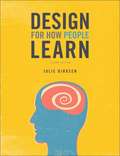- Table View
- List View
Design Better and Build Your Brand in Canva: A beginner's guide to producing professional branding, marketing, and social content for businesses
by Laura Goodsell Janine Friston Heather PalfreymanDiscover everything you need to get started with Canva, create a brand, and easily design professional-looking graphics to go from zero to pro in no timeKey FeaturesOrganize your business designs using folders and learn to schedule social media content in Canva's own content plannerLearn to create presentations, as well as video and animated social media postsDiscover the features of Canva to help you save time, including the brand kit, quick create and templatesBook DescriptionIf you're constantly frustrated by how long it takes to create a design in Canva, then you've come to the right place. This book will get you up and running quickly with creating professional branded graphics in Canva.You'll learn how to set up a Canva account, both free and pro and create a brand kit while understanding the importance of branding. Next, you'll discover all the features and tools as well as how to put everything together to build a brand you love and graphics that work for your business. As you progress, the chapters will show you how to organize your account, create presentations, use videos and animation within your marketing materials and more.By the end of this book, you'll have a solid understanding of what Canva is and what it does and be able to confidently and easily create a branded design from scratch.What you will learnUnderstand the fundamental capabilities and features of CanvaCreate a brand kit and understand what makes a good brandDevelop effective graphics to aid in increasing visibility on social media platformsFollow step-by-step tutorials to create stunning designsCreate a branded logo and learn about trademark and copyright guidelinesDiscover a world of color combinations, contrasts, and meanings for your brandExplore the fundamental design principlesUse videos, animation, and sounds in social graphics for your designsWho this book is forThis book is for aspiring designers, social media managers, VAs, service-based businesses and solopreneurs with basic experience in Canva, who are looking to advance in a new skill, while creating their brand and perfecting their social and marketing materials on a budget. A basic understanding of Canva, including setting up a free Canva account, creating a basic design using a template, adding images and text boxes and changing the color of fonts will be helpful but not essential.
The Design Collection Revealed: Adobe InDesign CS4, Photoshop CS4 & Illustrator CS4
by Chris Botello Elizabeth Eisner RedingNIMAC-sourced textbook
The Design Collection Revealed: Adobe InDesign CS5, Photoshop CS5 & Illustrator CS5
by Chris Botello Elizabeth Eisner RedingTHE DESIGN COLLECTION REVEALED provides comprehensive step-by-step instruction and in-depth explanation for three of today's most widely used design and layout programs: Adobe InDesign CS5, Adobe Photoshop CS5, and Adobe Illustrator CS5. Readers gain practical experience with the software as they work through end-of-chapter learning projects and step-by-step tutorials. An integration chapter demonstrates how to move from one application to the other. Full-color illustrations and a user-friendly design combine to create a robust learning experience that reveals how to master the latest features of Adobe's popular design suite.
Design Computing and Cognition '12
by John S. GeroDesign thinking, the label given to the acts of designing, has become a paradigmatic view that has transcended the discipline of design and is now widely used in business and elsewhere. As a consequence there is an increasing interest in design research. This is because of the realization that design is part of the wealth creation of a nation and needs to be better understood and taught. The continuing globalization of industry and trade has required nations to re-examine where their core contributions lie if not in production efficiency. Design is a precursor to manufacturing for physical objects and is the precursor to implementation for virtual objects. At the same time, the need for sustainable development requires the design of new products and processes, which feeds a movement towards design innovations and inventions. The papers in this volume are from the Fifth International Conference on Design Computing and Cognition (DCC'12) held at Texas A & M University, USA. They represent the state-of-the-art of research and development in design computing and design cognition. They are of particular interest to researchers, developers and users of advanced computation in design and those who need to gain a better understanding of designing.
Design Computing and Cognition '14
by John S. Gero Sean HannaThis book details the state-of-the-art of research and development in design computing and design cognition. It features more than 35 papers that were presented at the Sixth International Conference on Design Computing and Cognition, DCC'14, held at University College, London, UK. Inside, readers will find the work of expert researchers and practitioners that explores both advances in theory and application as well as demonstrates the depth and breadth of design computing and design cognition. This interdisciplinary coverage, which includes material from international research groups, examines design synthesis, design cognition, design creativity, design processes, design theory, design grammars, design support and design ideation. Overall, the papers provide a bridge between design computing and design cognition. The confluence of these two fields continues to build the foundation for further advances and leads to an increased understanding of design as an activity whose influence continues to spread. As a result, the book will be of particular interest to researchers, developers and users of advanced computation in design and those who need to gain a better understanding of designing that can be obtained through empirical studies.
Design Computing and Cognition ’18
by John S. GeroThis is the proceedings of the Eighth International Conference on Design Computing and Cognition (DCC’18) held at the Polytecnico di Milano in Italy. This volume presents both advances in theory and applications and demonstrates the depth and breadth of design computing and design cognition. Design thinking, the label given to the acts of designing, has become a paradigmatic view that has transcended the discipline of design and is now widely used in business and elsewhere. As a consequence there is an increasing interest in design research. This volume contains papers that represent the state-of-the-art research and developments in design computing and design cognition. This book is of particular interest to researchers, developers and users of advanced computation in design and those who need to gain a better understanding of designing that can be obtained through empirical studies.
Design Computing and Cognition’20
by John S. GeroThe papers in this volume are from the Ninth International Conference on Design Computing and Cognition (DCC’20) held virtually at the Georgia Institute of Technology, Atlanta, USA. They represent the state-of-the-art of research and development in design computing and design cognition including the increasingly active area of design cognitive neuroscience. They are of particular interest to design researchers, developers and users of advanced computation in designing as well as to design educators. This volume contains knowledge about the cognitive behavior of designers, which is valuable for those who need to gain a better understanding of designing.
Design Computing and Cognition’22
by John S GeroThis book reports research and development that represent the state of the art in artificial intelligence in design, design cognition, design neurocognition, and design theories from the Tenth International Conference on Design Computing and Cognition held in Glasgow, UK, in 2022. The 48 chapters are grouped under the headings of natural language processing and design; design cognition; design neurocognition; learning and design; creative design and co-design; shape grammars; quantum computing; and human behavior. These contributions are of particular interest to design researchers and design educators, as well as to users of advanced computation and cognitive science. This book contains knowledge about the cognitive and neurocognitive behavior of designers, which is valuable to those who need to gain a better understanding of designing.
Design Concepts in Programming Languages
by Franklyn Turbak David Gifford Mark A. SheldonChoice Outstanding Academic Title, 2009. Hundreds of programming languages are in use today--scripting languages for Internet commerce, user interface programming tools, spreadsheet macros, page format specification languages, and many others. Designing a programming language is a metaprogramming activity that bears certain similarities to programming in a regular language, with clarity and simplicity even more important than in ordinary programming. This comprehensive text uses a simple and concise framework to teach key ideas in programming language design and implementation. The book's unique approach is based on a family of syntactically simple pedagogical languages that allow students to explore programming language concepts systematically. It takes as its premise and starting point the idea that when language behaviors become incredibly complex, the description of the behaviors must be incredibly simple. The book presents a set of tools (a mathematical metalanguage, abstract syntax, operational and denotational semantics) and uses it to explore a comprehensive set of programming language design dimensions, including dynamic semantics (naming, state, control, data), static semantics (types, type reconstruction, polymporphism, effects), and pragmatics (compilation, garbage collection). The many examples and exercises offer students opportunities to apply the foundational ideas explained in the text. Specialized topics and code that implements many of the algorithms and compilation methods in the book can be found on the book's Web site, along with such additional material as a section on concurrency and proofs of the theorems in the text. The book is suitable as a text for an introductory graduate or advanced undergraduate programming languages course; it can also serve as a reference for researchers and practitioners.
Design Cybernetics: Navigating the New (Design Research Foundations)
by Thomas Fischer Christiane M. HerrDesign Cybernetics: Navigating the New Design cybernetics offers a way of looking at ourselves – curious, creative, and ethical humans – as self-organising systems that negotiate their own goals in open-ended explorations of the previously unknown. It is a theory of and for epistemic practices (learning, designing, researching) that is deeply committed to the autonomy of others and hence offers no prescriptive methodology. Design cybernetics describes design practice as inextricable from conversation – a way of enquiring, developing shared understanding and reaching the new that harnesses reliable control as well as error and serendipity. Recognising circular causality, observer-dependency and non-determinability, design cybernetics extends beyond tenets of scientific research into the creative, ethical and aesthetic domain. From this perspective, design is not an ill-conceived subset of scientific research. Instead, scientific research emerges as a particularly restricted subset of the broader human activity of design. This volume offers a cross-section of design cybernetic theory and practice with contributions ranging across architecture, interior lighting studies, product design, embedded systems, design pedagogy, design theory, social transformation design, research epistemology, art and poetics, as well as theatre and acting. Addressing designers, design educators and researchers interested in a rigorous, practice-based epistemology, it establishes design cybernetics as a foundational perspective of design research. “This is a conceptually elegant, well structured, and comprehensive presentation of design cybernetics. It fills a gap in the literature of the field.” Ken Friedman, Chair Professor, Tongji University “This book offers a valuable and timely introduction to second-order cybernetics as society grapples with complex issues like climate change and rising inequality.” Joichi Ito, Director of the MIT Media Lab
Design, Empathy, Interpretation: Toward Interpretive Design Research (Design Thinking, Design Theory)
by Ilpo KoskinenA new, empathic approach to design research, drawn from the informed experiences of a leading design research program in Finland.Design, Empathy, Interpretation tells the story of empathic design, a design research program at Aalto University in Helsinki, Finland, that has developed an interpretive approach to design over the past twenty years. As one of the leaders of the Helsinki group, Ilpo Koskinen draws on his own experiences to offer readers a general intellectual and professional history of design research, and argues for what he calls an interpretive approach. Design, Empathy, Interpretation shows how the group has created connections all across the globe, and how a seemingly soft approach to design research can be useful in both industry and government.Koskinen follows design research&’s transformation from questions of usability, in the 1980s, through to the revolution in personal electronics and the &“user-centered&” turn of the 1990s. Using the research community in Helsinki as a case study, and moving between specific projects and theoretical debates, he offers readers a focused introduction to the major methodological and intellectual challenges—as well as the opportunities—of design research. He argues that all design tasks, however simple or complex, begin with understanding the way humans ascribe meaning, both as individuals and as actors in complex societies. Thus all design research must be interpretive at its core.A new, empathic approach to design research, drawn from the informed experiences of a leading design research program in Finland.
Design Engineering and Science
by Nam Pyo Suh Miguel Cavique Joseph Timothy FoleyDesign Engineering and Science teaches the theory and practice of axiomatic design (AD). It explains the basics of how to conceive and deliver solutions to a variety of design problems. The text shows how a logical framework and scientific basis for design can generate creative solutions in many fields, including engineering, materials, organizations, and a variety of large systems.Learning to apply the systematic methods advocated by AD, a student can construct designs that lead to better environmental sustainability and to increased quality of life for the end-user at the same time reducing the overall cost of the product development process. Examples of previous innovations that take advantage of AD methods include:• on-line electric vehicle design for electric buses with wireless power supply;• mobile harbors that allow unloading of large ships in shallow waters;• microcellular plastics with enhanced toughness and lower weight; and• organizational changes in companies and universities resulting in more efficient and competitive ways of working.The book is divided into two parts. Part I provides detailed and thorough instruction in the fundamentals of design, discussing why design is so important. It explains the relationship between and the selection of functional requirements, design parameters and process variables, and the representation of design outputs. Part II presents multiple applications of AD, including examples from manufacturing, healthcare, and materials processing.Following a course based on this text students learn to create new products and design bespoke manufacturing systems. They will gain insight into how to create imaginative design solutions that satisfy customer needs and learn to avoid introducing undue complexity into their designs. This informative text provides practical and academic insight for engineering design students and will help instructors teach the subject in a novel and more rigorous fashion. Their knowledge of AD will stand former students in good stead in the workplace as these methods are both taught and used in many leading industrial concerns.
Design Essentials for the Motion Media Artist: A Practical Guide to Principles & Techniques
by Angie TaylorMaster the fundamental concepts and techniques of motion media design so you can apply--and occasionally break--the rules to achieve your communication goals. This authoritative guide presents all of the design essentials in an engaging and inspiring way. Each principle is explained with text, illustration and photography where necessary. An accompanying website will contain any necessary digital files for download, updates and links to other resources.
Design Ethnography: Epistemology and Methodology (SpringerBriefs in Anthropology)
by Francis MüllerThis open access book describes methods for research on and research through design. It posits that ethnography is an appropriate method for design research because it constantly orients itself, like design projects, towards social realities. In research processes, designers acquire project-specific knowledge, which happens mostly intuitively in practice. When this knowledge becomes the subject of reflection and explication, it strengthens the discipline of design and makes it more open to interdisciplinary dialogue. Through the use of the ethnographic method in design, this book shows how design researchers can question the certainties of the everyday world, deconstruct reality into singular aesthetic and semantic phenomena, and reconfigure them into new contexts of signification. It shows that design ethnography is a process in which the epistemic and creative elements flow into one another in iterative loops. The goal of design ethnography is not to colonize the discipline of design with a positivist and objectivist scientific ethos, but rather to reinforce and reflect upon the explorative and searching methods that are inherent to it. This innovative book is of interest to design researchers and professionals, including graphic artists, ethnographers, visual anthropologists and others involved with creative arts/media.
The Design, Experience and Practice of Networked Learning
by Vivien Hodgson Maarten De Laat David Mcconnell Thomas RybergThe Design, Experience and Practice of Networked Learning Edited by: Vivien Hodgson, Maarten de Laat, David McConnell and Thomas Ryberg This book brings together a wealth of new research that opens up the meaning of connectivity as embodied and promised in the term ''networked learning''. Chapters explore how contexts, groups and environments can be connected rather than just learners; how messy, unexpected and emergent connections can be made rather than structured and predefined ones; and how technology connects us to learning and each other, but also shapes our identity. These exciting new perspectives ask us to look again at what we are connecting and to revel in new and emergent possibilities arising from the interplay of social actors, contexts, technologies, and learning. Caroline Haythornthwaite, University of British Columbia Despite creating fundamentally new educational economics and greatly increasing access - teaching and learning in networks is a tricky business. These chapters illuminate the complex interactions amongst tools, pedagogy, educational institutions and personal net presences - helping us design and redesign our own networks. In the process, they take (or extract) network theory from the practice of real teaching and learning contexts, making this collection an important contribution to Networked Learning. Terry Anderson, Athabasca University What kinds of learning can social networking platforms really enable? Digging well beneath the hype, this book provides a timely, incisive analysis of why and how learning emerges (or fails to) in networked spaces. The editors do a fine job in guiding the reader through the rich array of theories and methods for tackling this question, and the diverse contexts in which networked learning is now being studied. This is a book for reflective practitioners as well as academics: the book''s close attention to the political, pedagogical and organisational complexity of effective practice, and the lived experience of educators and learners, helps explain why networked learning has such disruptive potential -- but equally, why it draws resistance from the establishment. Simon Buckingham Shum, The Open University The networked learning conference, a biannual institution since 1998, celebrates its 14th year in this volume. Here a range of studies, reflecting networked learning experiments across Europe and other global contexts , show important shifts away from a conservative tradition of OEe-learning¹ research and unpeel dilemmas of promoting learning as an elusive practice in virtual environments. The authors point towards important futures in online learning research, where notions of knowledge, connectivity and OEcommunity¹ become increasingly elastic, and engagements slide across material and virtual domains in new practices whose emergence is increasingly difficult to apprehend. Tara Fenwick - University of Stirling. The chapters in this volume explore new and innovative ways of thinking about the nature of networked learning and its pedagogical values and beliefs. They pose a challenge to us to reflect on what we thought networked learning was 15 year ago, where it is today and where it is likely to be headed. Each chapter brings a particular perspective to the themes of design, experience and practice of networked learning, the chosen focus of the book. The chapters in the book embrace a wide field of educational areas including those of higher education, informal learning, work-based learning, continuing professional development, academic staff development, and management learning. The Design, Experience and Practice of Networked Learning will prove indispensable reading for researchers, teachers, consultants, and instructional designers in higher and continuing education; for those involved in staff and educational development, and for those studying post graduate qualifications in learning and teaching. This, the second volume in the Springer Book Series on Researching Networked Learning, is based on a selection of papers presented a...
Design for Care
by Peter JonesThe world of healthcare is constantly evolving, ever increasing in complexity, costs, and stakeholders, and presenting huge challenges to policy making, decision making and system design. In Design for Care, we'll show how service and information designers can work with practice professionals and patients/advocates to make a positive difference in healthcare.
Design for CNC: Practical Joinery Techniques, Projects, and Tips for CNC-Routed Furniture
by Gary Rohrbacher Anne Filson Anna Kaziunas France Bill YoungDesign, DIY, and computer-controlled fabrication are a powerful combination for making high-quality customized things. Written by the founders of the architecture, design, and research firm Filson and Rohrbacher, this book takes you through the basics of CNC fabrication, the design process, production, and construction of your own furniture designs. Through their AtFAB series of projects, accompanied by an overview of digital techniques and design thinking, this book introduces the knowledge and skills that you'll find widely applicable across all kinds of CNC projects. Not only will you learn how to design, fabricate, and assemble a wide range of projects, you'll have some great furniture to show for it! While 3D printing has been grabbing headlines, high school, college, library, and other public makerspaces have been making things with CNC machines. With a CNC router, you can cut parts from strong, tactile, durable materials like wood. Once you have your design and material, you can set up your job and let it run. When it's done, you can put the project together for an heirloom of your own. While 3D printing can make exciting things with complex designs, CNCs are the digital workhorses that produce large-scale, long-lasting objects.
Design for Developers
by Stephanie StimacSolve common application design and usability issues with flair! These essential design and UX techniques will help you create good user experiences, iterate smoothly on frontend features, and collaborate effectively with designer colleagues.In Design for Developers you will learn how to: Use color, typography, and layout to create hierarchy on a web page Apply color palettes consistently in a user interface Choose the correct typefaces and fonts Conduct user research to validate design decisions Quickly plan a website&’s layout and structure In Design for Developers, author Stephanie Stimac shares the unique insights she&’s learned as a designer on the Microsoft Developer Experiences team. This one-of-a-kind book provides a developer-centric approach to the essential design fundamentals of modern web applications. You&’ll learn how to craft a polished visual design with just color, space, and typeface, and put all your new skills into practice to design a website from scratch. Foreword by Aaron Gustafson. About the technology Developer-made design decisions can have a real impact on a site&’s user experience. Learn to speak design&’s language, and you&’ll be able to confidently contribute to a design process, collaborate with designer colleagues, and make more informed decisions about how you build your apps. About the book Design for Developers reveals essential design and UX principles every web developer needs to know. You&’ll love the book&’s developer-centric approach, which demonstrates new ideas with examples from popular sites and user interfaces. Discover insightful techniques for user research, and learn to use color, typography, and layout to create communicative web visuals. By the time you&’re done reading, you&’ll know it&’s true: having good design sense will make you a better web developer! What's inside Conduct user research to validate design decisions Quickly plan a website&’s layout and structure Iterate smoothly on frontend features Use color, typography, and layout to create hierarchy on a web page About the reader For web developers familiar with HTML, CSS, and the JavaScript basics. About the author Stephanie Stimac is a design technologist and senior product manager who focuses on building and improving developer experiences. She has previously worked on the Microsoft Edge browser. Table of Contents PART 1 DESIGN BASICS 1 Bridging the gap between design and development 2 Design fundamentals PART 2 USER EXPERIENCE 3 User experience basics 4 User research 5 User experience design PART 3 VISUAL DESIGN ELEMENTS 6 Web layout and composition 7 Enhancing web layout with animation 8 Choosing and working with typography on the web 9 Color theory 10 Building a website PART 4 AFTER VISUAL DESIGN 11 Test, validate, iterate 12 Developer choices and user experience
Design for Ergonomics (Springer Series in Design and Innovation #2)
by Francesca TosiThis book focuses on the global quality of the design of systems that people interact with during their work activities and daily lives; a quality that involves the globality of people’s experience – physical, sensory, cognitive and emotional. It presents a concise and structured overview of the ergonomic approach to planning, and of methodological and operational tools from ergonomic research that can more directly and concretely contribute to the design process. The book also explores physical ergonomics and cognitive ergonomics, which are essential components of design culture. The final section addresses the main design problems and intervention criteria regarding the design of environments, products and equipment, as well as the design of communication, training and learning interface systems based on digital technologies. The book is chiefly intended for designers and anyone interested in the methods, tools and opportunities for in-depth analysis and development that ergonomics can offer regarding the conception, production and testing of products, environments and services, whether physical or virtual. It also offers a learning resource for professionals and students in Industrial Design and Planning.
Design for Experience
by Jinwoo KimPresents a strategic perspective and design methodology that guide the process of developing digital products and services that provide 'real experience' to users. Only when the material experienced runs its course to fulfilment is it then regarded as 'real experience' that is distinctively senseful, evaluated as valuable, and harmoniously related to others. Based on the theoretical background of human experience, the book focuses on these three questions: How can we understand the current dominant designs of digital products and services? What are the user experience factors that are critical to provide the real experience? What are the important HCI design elements that can effectively support the various UX factors that are critical to real experience? Design for Experience is intended for people who are interested in the experiences behind the way we use our products and services, for example designers and students interested in interaction, visual graphics and information design or practitioners and entrepreneurs in pursuit of new products or service-based start-ups.
Design for Hackers: Reverse Engineering Beauty
by David KadavyMany design books try to teach design through lists of "do's" and "don'ts." But hackers know you need a deeper understanding of something to really do it well. Design for Hackers takes apart design by "reverse-engineering" Impressionist painting, Renaissance sculpture, the Mac OS X Aqua interface, Twitter's web interface, and much more. You'll learn about color theory, typography, proportions, and design principles. This theoretical advice is mixed with concrete, actionable advice such as suggestions for color scheme tools, and a chart of "all of the fonts you'll ever need".
Design for Hackers: Reverse Engineering Beauty
by David KadavyDiscover the techniques behind beautiful design by deconstructing designs to understand them The term 'hacker' has been redefined to consist of anyone who has an insatiable curiosity as to how things work—and how they can try to make them better. This book is aimed at hackers of all skill levels and explains the classical principles and techniques behind beautiful designs by deconstructing those designs in order to understand what makes them so remarkable. Author and designer David Kadavy provides you with the framework for understanding good design and places a special emphasis on interactive mediums. You'll explore color theory, the role of proportion and geometry in design, and the relationship between medium and form. Packed with unique reverse engineering design examples, this book inspires and encourages you to discover and create new beauty in a variety of formats. Breaks down and studies the classical principles and techniques behind the creation of beautiful design Illustrates cultural and contextual considerations in communicating to a specific audience Discusses why design is important, the purpose of design, the various constraints of design, and how today's fonts are designed with the screen in mind Dissects the elements of color, size, scale, proportion, medium, and form Features a unique range of examples, including the graffiti in the ancient city of Pompeii, the lack of the color black in Monet's art, the style and sleekness of the iPhone, and more By the end of this book, you'll be able to apply the featured design principles to your own web designs, mobile apps, or other digital work.
Design for High Performance, Low Power, and Reliable 3D Integrated Circuits
by Sung Kyu LimThis book provides readers with a variety of algorithms and software tools, dedicated to the physical design of through-silicon-via (TSV) based, three-dimensional integrated circuits. It describes numerous "manufacturing-ready" GDSII-level layouts of TSV-based 3D ICs developed with the tools covered in the book. This book will also feature sign-off level analysis of timing, power, signal integrity, and thermal analysis for 3D IC designs. Full details of the related algorithms will be provided so that the readers will be able not only to grasp the core mechanics of the physical design tools, but also to be able to reproduce and improve upon the results themselves. This book will also offer various design-for-manufacturability (DFM), design-for-reliability (DFR), and design-for-testability (DFT) techniques that are considered critical to the physical design process.
Design For How People Learn (Voices That Matter)
by Julie DirksenIn this book, you will discover how to use the key principles behind learning, memory, and attention to create materials that enable your audience to both gain and retain the knowledge and skills you're sharing. Updated to cover new insights and research into how we learn and remember, this new edition includes new techniques for using social media for learning as well as two brand new chapters on designing for habit and best practices for evaluating learning, such as how and when to use tests. Using accessible visual metaphors and concrete methods and examples, this book will teach you how to leverage the fundamental concepts of instructional design both to improve your own learning and to engage your audience.
Design For Kids
by Debra Levin GelmanEmotion. Ego. Impatience. Stubbornness. Characteristics like these make creating sites and apps for kids a daunting proposition. However, with a bit of knowledge, you can design experiences that help children think, play, and learn. With Design for Kids, you'll learn how to create digital products for today's connected generation.
